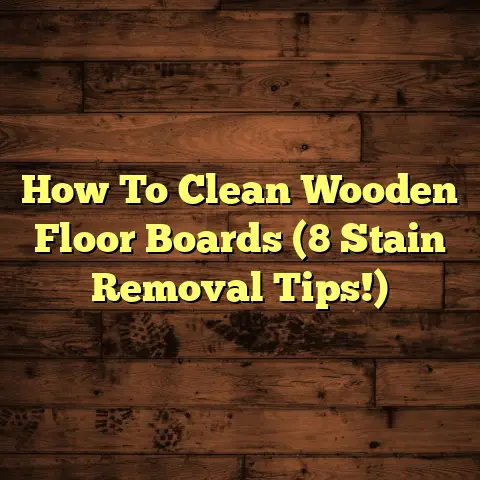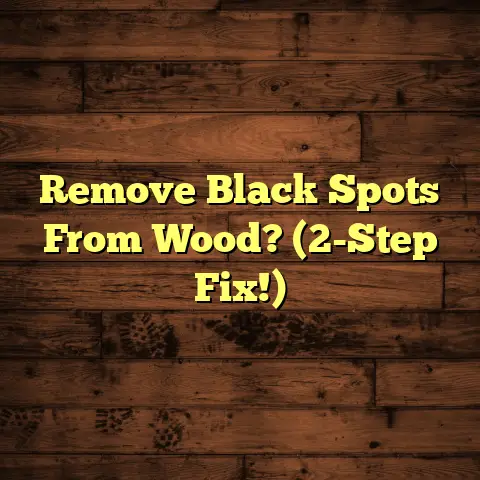Fix Gouges in Hardwood Floors? (4 Repair Tricks!)
Ever tripped over a rogue toy or dragged furniture across your beautiful hardwood floors and cringed?
Yeah, me too.
According to a survey by the National Wood Flooring Association, nearly 90% of homeowners with hardwood floors report experiencing at least one significant gouge or scratch over time.
It’s practically a hardwood floor rite of passage!
But don’t panic!
Those dents and dings don’t have to be a permanent eyesore.
I’m here to share my expert tips on how to tackle those pesky gouges and restore your floors to their former glory.
Let’s dive in!
Understanding Gouges in Hardwood Floors
So, what exactly is a gouge?
It’s more than just a surface scratch.
Think of it as a deeper indentation, where the wood fibers have been compressed or removed.
A scratch is usually superficial, affecting only the finish, while a gouge goes deeper, impacting the wood itself.
What causes these hardwood floor battle scars?
Oh, the usual suspects:
- Heavy Furniture: Moving that massive bookshelf without proper protection? Gouge city!
- Pet Claws: Our furry friends can be tough on floors, especially during zoomies.
- Moving Appliances: Ever tried to shimmy a
refrigerator across the kitchen?
I’ve seen some serious damage from that! - Dropped Objects: A hammer falling off a table or counter can leave a mark on the floor.
These seemingly small imperfections can impact your home’s aesthetics and value.
I once had a client who was selling their house, and the inspector pointed out several prominent gouges in the living room floor.
It ended up costing them a few thousand dollars in negotiations!
Addressing those gouges promptly can save you money and maintain your home’s beauty.
Assessing the Damage
Before you grab any tools, let’s assess the damage.
This step is crucial to choosing the right repair method.
Here’s a quick guide:
Inspect the Gouge: How deep is it?
Does it penetrate the finish only, or does it dig into the wood itself?Identify the Finish: Is your floor finished with polyurethane, varnish, or something else?
This will affect the products you use for repair.If you’re unsure, try this little test: * Find an inconspicuous area (like inside a closet).
* Place a drop of mineral spirits on the floor.
* If it beads up, you likely have a polyurethane finish.
* If it soaks in, it’s probably varnish or another penetrating finish.Consider the Location: Is the gouge in a high- traffic area?
This will influence the durability of your repair.
Once you have a good understanding of the damage, you can choose the appropriate repair trick.
Repair Trick #1 – The Crayon Method
Yes, you read that right – crayons!
This is a simple and surprisingly effective method for shallow gouges.
Think of it as a quick “Band-Aid” for your floor.
Materials You’ll Need:
- Colored Wax Crayons: Choose colors that closely
match your floor.
A variety pack is helpful for blending. - Plastic Scraper: An old credit card works well.
- Soft Cloth: For buffing.
Here’s How to Do It:
- Clean the Area: Remove any dirt or debris from the gouge.
- Select the Crayon: Choose a crayon that matches
the color of your floor as closely as possible.
If you can’t find an exact match, blend two or more colors together. - Fill the Gouge: Press the crayon firmly into the gouge, filling it completely.
- Scrape Away Excess: Use the plastic scraper to remove any excess crayon wax, holding it at a slight angle.
- Buff the Area: Use the soft cloth to buff the area, blending the crayon wax with the surrounding finish.
- Repeat if Necessary: If the gouge is still visible, repeat the process.
Tips for Success:
- Color Matching is Key: Take your time to find the right crayon color.
- Melt the Crayon Slightly: Warming the crayon with a hairdryer can make it easier to apply.
- Don’t Overfill: It’s better to apply multiple thin layers than one thick layer.
The crayon method is best for minor imperfections.
It’s not a permanent fix, but it can significantly improve the appearance of your floor.
Repair Trick #2 – Wood Filler and Stain
For deeper gouges that penetrate the wood, wood filler is your best friend.
This method requires a bit more effort, but it provides a more durable and seamless repair.
Materials You’ll Need:
- Wood Filler: Choose a color that closely matches your floor.
- Putty Knife: For applying the filler.
- Sandpaper: Fine-grit (220-grit) for smoothing.
- Wood Stain: To match the surrounding wood.
- Protective Seal: Polyurethane or varnish.
Here’s a Step-by-Step Guide:
- Clean the Area: Remove any dirt or debris from the gouge.
- Apply Wood Filler: Use the putty knife to apply the wood filler to the gouge, filling it slightly above the surface of the floor.
- Allow to Dry: Let the wood filler dry completely
according to the manufacturer’s instructions.
This usually takes several hours. - Sand the Area: Use fine-grit sandpaper to sand the area smooth, blending the wood filler with the surrounding floor.
- Apply Stain: Apply wood stain to the filled area,
matching the color of the surrounding wood.
You may need to apply multiple coats to achieve the desired color. - Apply Protective Seal: Apply a protective seal (polyurethane or varnish) to the repaired area to protect it from wear and tear.
Important Considerations:
- Drying Time: Be patient! Let the wood filler dry completely before sanding.
- Sanding Technique: Use light, even strokes to avoid damaging the surrounding floor.
- Stain Matching: Test the stain in an inconspicuous area before applying it to the repaired area.
Wood filler is a great option for more significant gouges.
It provides a strong and durable repair that can last for years.
Repair Trick #3 – Using a Touch-Up Kit
Hardwood floor touch-up kits are like a Swiss Army knife for floor repairs.
They typically include a variety of tools and materials to address different types of damage.
What’s in a Touch-Up Kit?
- Color-Matching Putty: To fill in gouges and dents.
- Markers or Pens: To conceal scratches and blemishes.
- Finish Restorer: To blend the repaired area with the surrounding finish.
- Applicators: Brushes, cloths, and applicators for precise application.
How to Use a Touch-Up Kit:
- Clean the Area: As always, start with a clean surface.
- Fill the Gouge: Use the color-matching putty to fill in the gouge, following the instructions provided in the kit.
- Conceal Scratches: Use the markers or pens to conceal any scratches or blemishes.
- Apply Finish Restorer: Apply the finish restorer to blend the repaired area with the surrounding finish.
- Allow to Dry: Let the repaired area dry completely according to the manufacturer’s instructions.
Advantages of Touch-Up Kits:
- Convenience: Everything you need is in one kit.
- Versatility: Can be used for a variety of repairs.
- Ease of Use: Simple instructions make it easy for beginners.
Touch-up kits are ideal for minor to moderate damage.
They’re a great option for homeowners who want a quick and easy solution.
Repair Trick #4 – Professional Refinishing
Sometimes, the damage is too extensive or complex for a DIY repair.
That’s when it’s time to call in the pros.
When to Consider Professional Refinishing:
- Deep Gouges: Gouges that penetrate deeply into the wood.
- Extensive Damage: Numerous gouges and scratches throughout the floor.
- Unsure About DIY: If you’re not confident in your ability to repair the floor yourself.
What to Expect from Professional Refinishing:
- Sanding: The existing finish is sanded down to bare wood.
- Repairing: Gouges and other imperfections are repaired with wood filler.
- Staining (Optional): The floor is stained to the desired color.
- Sealing: Multiple coats of protective sealant are applied.
Cost and Time:
Professional refinishing can be expensive, ranging from \$3 to \$8 per square foot.
The process can take several days, depending on the size of the area.
The Results:
Professional refinishing can completely transform your hardwood floors.
It’s like getting a brand new floor without the expense of replacement.
I had a client who had inherited a house with severely damaged hardwood floors.
They were covered in gouges, scratches, and stains.
After professional refinishing, the floors looked absolutely stunning.
It completely changed the look and feel of the house.
Finding a Reputable Contractor:
- Get Referrals: Ask friends, family, or neighbors for recommendations.
- Check Online Reviews: See what other customers have to say.
- Get Multiple Quotes: Compare prices and services from different contractors.
- Verify Licensing and Insurance: Make sure the contractor is properly licensed and insured.
Professional refinishing is a significant investment, but it can be well worth it if you want to restore your hardwood floors to their original beauty.
Conclusion
So, there you have it – four repair tricks to tackle those pesky gouges in your hardwood floors.
Whether you choose the crayon method, wood filler, a touch-up kit, or professional refinishing, there’s a solution for every situation.
Remember, addressing gouges promptly can save you money and maintain your home’s value.
Maintaining your hardwood floors is an investment in your home’s overall value and aesthetic appeal.
Call to Action
Now, I want to hear from you!
Have you ever dealt with gouges in your hardwood floors?
Which repair tricks have worked best for you?
Share your experiences in the comments below!





